Pail-Piran on Soon Valley,District Khushab,Punjab,Pakistan’sCanvas
On April 6, 2015 - Family Tree
The ‘Soon Valley’ (Urdu: [[وادئ سون)]] or Soon Sakesar is located in the northwest of Khushab District, Punjab, Pakistan. Eeastern border of Soon Valley starts from Poodhrar village and western border land mark is Sakesar. The Sakesar is the highest mountain peak in the region, 5010 feet highest peak of the Salt Range. The valley is 35 mile long and 9 mile wide.Important towns in the valley are Pail-Piran,Naushahra, Chitta, Sabhral, Khoora, Nowshera, Kufri, Anga, UGALISHARIF, Mardwal, Dhadhar, Uchali and Bagh Shams-ud-Din. Kanhatti Garden, Sodhi Garden, Da’ep and Sakesar are resorts located in the valley. The Awan tribe is settled in Soon Valley. Pail-Piran village is home to Hashmite Sadaats-descendents of Baha ud Din Zakkariyya Multani. Rajpoot Janjua resides in the villages of Katha Saghraal and Katha Misraal, on the foothill of Salt Range, outside the Soon valley.
Information
Total villages = 31
Main villages = Padhrar, Pail-Piran, Naushahra,Ugalisharif,Mukrumi,Dhadhar, Mardwal, Kufri, Uchali, Khoora,Anga,Khabakki, kuradhi etc
Distance from Islamabad = 290 km
Distance from Sargodha = 110 km
Lakes = Ugalisharif& Uchali, Khabbaki, Jahlar, Khura Shrine=Baba Shikh Akbar din Of UgaliSharif = Roiza Mubarik Pir Khawaja Noori in Pail-Piran
Total villages = 31
Main villages = Padhrar, Pail-Piran, Naushahra,Ugalisharif,Mukrumi,Dhadhar, Mardwal, Kufri, Uchali, Khoora,Anga,Khabakki, kuradhi etc
Distance from Islamabad = 290 km
Distance from Sargodha = 110 km
Lakes = Ugalisharif& Uchali, Khabbaki, Jahlar, Khura Shrine=Baba Shikh Akbar din Of UgaliSharif = Roiza Mubarik Pir Khawaja Noori in Pail-Piran
Pir sahib Acha(Pir Haccha)
On April 6, 2015 - Family Tree
Pir sahib Acha(Pir Haccha) was one of the reverened decendents of Pir Sahib Khawja Noori of Pail-Piran.He was Wali-E-Kamil and Sahib-E- Karamat. He is buried in Pail-Piran in the family graveyard of Pir family on the main Chakwal-Khushab Road.A water well known as ‘Pir Haccha daa Choha’ is located close to Pail-Piran near village Kutcher, and many visitors use the water of the well as cure for skin diseases
On April 6, 2015 - Family Tree
- Pir Fateh Shah( Family Fateh Shahaal gets its name after him)
- Pir Ibn Shah
- Pir Khawja Noori
- Pir Ali Qattal Shah
- Sheikh Sadar Ud Din
- Sheikh Mohammad Yousaf(Pir Rukkan Ud Din)
- Sheikh Imad Ud Din Mohammad
- Sheikh Ruklkan Ud Din Ismail Samar Qandi
- Sheikh Sadar Ud Din Mohammad Haji
- Sheikh Imad Ud Din Ismail Shaheed
- Sheikh Ul Islam Sadar Ud Din Arif Billah
- Sheikh Ul Islam Hazrat Ghous Baha Ud Din Zakkariyya(Pir Baha Wul Haq)Multani
- Sheikh Wajih Ud Din Shah Mohammad Ghous
- Sheikh Kamal Ud Din Aba Bakar
- Sultan Sheikh Jalal Ud Din
- Sheikh Ali Qazi
- Sheikh—Ud Din Shaeed
- Sultan Hussain-Sultan Matrif
- Sultan Hazeema
- Sultan Abd Allah
- Sultan Hazim
- Amir Taj Ud Din El Matrif
- Abd Ur rahman
- Hazrat HabbarHabbaira Tul Assadi-The Habbari (the Habbarid Dynasty) get their name after him
- Hazrat Asad
- Hazrat Hashim(Hashmite Dynasty gets their name after him).
His elder brother Pir Ghulam Haider Shah left three sons Pir Asghar Hussain Shah,Pir Tanvir Hussain Shah and Syed Munir Hussain Shah. While Pir Walayat Shah left four sons Syed Sajid Hussain Shah,Dr.Syed Wajid Pirzada,Syed Majid Hussain Shah and Syed Zahid Hussain Shah.Yet other sources claim that Hazrat Habbar was son of Aswad>Matlib>Asad>Abd Ul Azza>Qussay>Kallab(Qureish-the Qureshi dynasty get their name after him) and not of Asad Bin Hazrat Hashim.They maintain that hazrat Asadf bin Hashim had no son.This was incorrect as an arabic account in book “Ansab ul Arab” shows Hanain as son of Asad.
وفاطمة بنت أسد بن هاشم بن عبد مناف، وهي من المهاجرات المبايعات؛ أم جميع ولد أبي طالب: علي، وجعفر وعقيل، وأم هانيء، وطالب، بني أبي طالب، وابن أخيها عبد الله بن
حنين بن أسد بن هاشم، لا عقب له.
حنين بن أسد بن هاشم، لا عقب له.
Posts in Category: Family Tree
Pirs of Pail-Piran are the decendents of Baha Ud Din Zakkariyya
On April 15, 2015 - Family Tree
aha-ud-din Zakariya’s Mausoleum in Multan
Hazrat Baha-ud-din Zakariya (Persian: بہاؤ الدین زکریا) was a Sufi of Suhrawardiyya order. His full name was Al-Sheikh Al-Kabir Sheikh-ul-Islam Baha-ud-Din Abu Muhammad Zakaria Al-Qureshi Al-Asadi Al Hashmi.Sheikh Baha-ud-Din Zakariya known as Bahawal Haq was born atKot Kehror, a town of Layyah District near Multan, Punjab,Pakistan around 1170.
His grand father Shah Kamaluddin Ali Shah Qureshi al Hashmiarrived Multan from Makkah en route to Khwarizm where he stayed for a short while. He was from the descendents of Asad Ibn Hashim the maternal grandfather of Hadhrat Ali ibn Abi Talib RA.Arrival of Habbarids(the descendents of Habbar bin Asad in Sindh): In Tariqat he was the disciple of Renowned Sufi Master ShaikhShahab al-Din Suhrawardi who awarded him Khilafat only after 17 days of stay at his Khanqaah in Baghdaad.
For fifteen years he went from place to place to preach Islam and after his wanderings Bahawal Haq settled in Multan in 1222.
- His Shrine
- Memorandum
His Shrine
Hazrat Baha-ud-din Zakariya died in 1267 and his mausoleum is located at Multan. The of mausoleum is a square of 51 feet 9 inches, measured internally. Above this is an octagon, about half the height of the square, which is surmounted by a hemispherical dome. The Mausoleum was almost completely ruined during the siege of 1848 by the British, but was soon afterwards restored by the Muslims.
Memorandum
A train is named after him, which runs between Karachi and Multan.
- Largest university of South Punjab is also called Bahauddin Zakariya University.
Descendents of Hazrat Baha ud Din Zakkariyya are spread across Pakistan,and among them are Pirs of Pail-Piran(district Khushab),where descendents of one of his grandsons(Pir Ali Qatal) are settled,Bhera Sharif(district Sargodha),Pir da Khara & Karuli Piran(district Jhelum). Bahauddin Zakariya Multani was a Asadi Hashmi ( Descendent of Asad ibn Hashim) and he is truly called as Quraishi Asadi Hashmi.
Pir families of Pail-Piran
On April 15, 2015 - Family Tree
There are 3 main families of Hashmite Sadaat of Pail-Piran, all are descendents of Pir Khawja Noori- namely Fateh Shah-aal(Fatehshhaal), Daim Shah-aal(Daimshahhaal) and Kalay Shah-aal(Kalayal) with two sub families namely Sharaf Shah-aal(Sharafshhaal) and Sonay Shah-aal(Sonayshahhaal) who are closely related to the last two main families.Some of Pir families of Pail-Piran have moved to places like Karuli-Piran,Thoha Bahadur,Pir Khanwaal etc in Chakwal district.While Pirs of Bhera Sharif (district Sargodha) and Pir Da Khara(district Chakwal) are closely related to these families.
Silsala- E -Tarikat
On April 15, 2015 - Family Tree
Since the Piran E Pail are descendents of Hazrat Ba Ud din Zakkariyya- a disciple of Hazrat Shahab Ud Din Soharwardi,Baghdadi*, they followSoharwardia,and fromFiqah school view point they are followers of Imam Abu Hanifah.
One of the able son of this family Late Pir Karam Shah El Azhari,of Bhera Sharif,had been instrumental in promoting the Hanafi Fiqah through his teachings and writings.He authored volumes of Tafseer E Quran(Zia ul Quran) and Seerah Paak (way of Prohhet Mohammad PBUH)-Zia Un Nabi.
*Sheikh Shahab-ud-din Muhammad Suhrawardi son of Abu Najib, was born in Suhraward and died in Baghdad.
*Sheikh Shahab-ud-din Muhammad Suhrawardi son of Abu Najib, was born in Suhraward and died in Baghdad.
Arrival and Rule (856-1026 CE) of Of Habbari Arab in Sindh
On April 15, 2015 - Family Tree
Arrival and Rule (856-1026 CE) of Habbari Arab in Sindh
Habbari dynasty ruled Sindh from 841 to 1024 C.E. Sindh was a province of Abbasid Caliphate. During the stuggle of dominance of Islamic world betwen Abassid and Fatimid Caliphate, Sindh became semi-independent under Arab ruler Aziz al-Habbari in 841 CE, though nominally remaining part of Abbasid Caliphate [1] [2] [3] The Hubbari ruled Sindh, Makran, Turan, Khuzdar and Multan from their capital city of Mansura. In 854 CE Abbasid caliph Al-Mutawakkil appointed Aziz al-Habbari governor of Sindh. Aziz al-Habbari was followed by his son Umar al-Habbari I. His son Abdullah al-Habbari succeded him and his grandson,Umar al-Habbari II was ruling when famous Arab historian Al-Masudi visited Sindh. Habbari dynasty ruled Sindh until 1024 (Khafif al-Habbari, last ruler of the Habbari dynasty).
Habbari dynasty ruled Sindh from 841 to 1024 C.E. Sindh was a province of Abbasid Caliphate. During the stuggle of dominance of Islamic world betwen Abassid and Fatimid Caliphate, Sindh became semi-independent under Arab ruler Aziz al-Habbari in 841 CE, though nominally remaining part of Abbasid Caliphate [1] [2] [3] The Hubbari ruled Sindh, Makran, Turan, Khuzdar and Multan from their capital city of Mansura. In 854 CE Abbasid caliph Al-Mutawakkil appointed Aziz al-Habbari governor of Sindh. Aziz al-Habbari was followed by his son Umar al-Habbari I. His son Abdullah al-Habbari succeded him and his grandson,Umar al-Habbari II was ruling when famous Arab historian Al-Masudi visited Sindh. Habbari dynasty ruled Sindh until 1024 (Khafif al-Habbari, last ruler of the Habbari dynasty).
Habbarid Dynasty introduced Coins with Arabic Script
On April 15, 2015 - Family Tree
Habbarid Dynasty(Amirs of Sind)
Ruler:
Abd al Rahman
Reigned:
c.950 AD
Denomination(Coin):
AR Damma
Obverse:
Arabic script
Reverse:
Arabic script
Reference:
Album 1494
Weight:
0.8 gms
Diameter:
10.4 mm
Habbarid (Amirs of Sind)
Abd al Rahman
Reigned:
c.950 AD
Denomination(Coin):
AR Damma
Obverse:
Arabic script
Reverse:
Arabic script
Reference:
Album 1494
Weight:
0.8 gms
Diameter:
10.4 mm
Habbarid (Amirs of Sind)
The Habbarids ruled in Sind from the 9th century to the 11th. Sind is in the north-west of the Indian sub-continent and today is part of Pakistan. It represents the greatest extent of the initial Arab expansion into the Indian sub-continent.
The Hashemite Dynasty
Hashemite, also Hashimite, is the Latinate version of the Arabic: هاشمي, transliteration: Hāšimī, and traditionally refers to those belonging to the Banu Hashim, or “clan of Hashim”, an Arabian clan within the larger Quraysh tribe. It also refers to an Arab dynasty whose original strength stemmed from the network of tribal alliances and blood loyalties in the Hejaz region of Arabia, along the Red Sea.
The Hashemites trace their ancestry from Hashim ibn ‘Abd Manaf (died c. 511 AD), the great-grandfather of the Islamic prophet, Muhammad, although the definition today mainly refers to the descendants of Muhammad’s daughter, Fatimah.[2] The early history of the Hashemites saw them in a continuous struggle against the Umayyads for control over who would be the Caliph or successor to Muhammad. The Umayyads were of the same tribe as the Hashemites, but a different clan. After the overthrow of the Umayyads, the Abbasids would present themselves as representatives of the Hashemites, as they claimed descent from Abbas ibn ‘Abd al-Muttalib, an uncle of Muhammad. Muhammad’s father had died before he was born, and his mother died while he was a child, so Muhammad was raised by his uncle Abu Talib ibn ‘Abd al-Muttalib, chief of the Hashemites.
From the 10th century onwards, the Sharif (religious leader) of Mecca and its Emir was, by traditional agreement, a Hashemite. Before World War I, Hussein bin Ali of the Hashemite Dhawu-‘Awn clan ruled the Hejaz on behalf of the Ottoman sultan. For some time it had been the practice of the Sublime Porte to appoint the Emir of Mecca from among a select group of candidates. In 1908, Hussein bin Ali was appointed to the Emirate of Mecca. He found himself increasingly at odds with the Young Turks in control at Istanbul, while he strove to secure his family’s position as hereditary Emirs.
Our Abodes
Hashemite Dynasty is spread over many countries in the world and has ruled Hejaz(Saudi Arabia), Hashemite Kingdom of Jordon, Iraq and Morocco for centuries.Details to this dynasty’s abodes and rulers are available on the homepage of this website. Likewise places where descendants of Hazrat Baha Ud Din Baha Ul Haq Zakariyya Multani (RA) got settled in the subcontinent are explicitly detailed in the research work of Maulna Noor Ahmad Afridi. His famous documented accounts are “Tazkara e Bah Ud Din Zakariyya Multani (RA)” “Tazkara E Sad’r Ud Din Arif Billah (RA)” and Tazkara E Shah RuK’n E Aalam (RA)”.
Students and scholars can consult PhD thesis of Dr. Shamim Zaidi on Hazrat Baha Ud Din Zakariyya (RA) and work of other scholars, especially from Baha Ud Din Zakariyya University (www.bzu.edu.pk).Here we are briefly listing, which is by no means is an exhaustive list, of some of the abodes of the relations of Piran E Pail in Punjab & KPK.
- Maddina ul Aaulia- Multan
- Pail-Piran, Tehsil & District Khushab, Punjab, Pakistan
- Bhera Sharif, District Sargodha
- Pir Da Khara, District Chakwal
- Karuli Piran District Chakwal
- Khairpur Sharif Disrict Chakwal
- Thoha Bahadur District Chakwal
- Pir Maidan District Chakwal
- Sardhi District Chakwal
- Titral Disrict Chakwal
- Pir Khanwal District Chakwal
- Dharrabi District Chakwal
- Pir Sarkal District Chakwal
- More Jhang District Chakwal
- Waula District Chakwal
- Chak 113 North, Sargodha
- Sargodha City
- Khushab City
- Chak 180 South, Sargodha
- Faisalabad city
- Palasi Piran District Abbottabad
- Marmoola Piran District Abbottabad
- Pattan, District Abbottabad
- Arhwari Piran, Murree
- Rawalpindi City
- Taxila
- Lahore city
- Peshawar City
Posts in Category: Location
Villages of Khusab
On April 15, 2015 - Location
Villages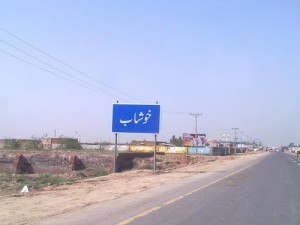

The Villages of Khushab are Anga, Balwal, Bansi, Bola, Daiwal(the hub of the Sanghas), Dhak, Girot, Hadali, Hassan Pur Tiwana (Hamoka), Jaba, Jalalpur Syedan Hamdania, Khabeki, Khatha, Khhotakka, Kufri, Kund, Mardwal, Mitha Tiwana, Mohib-Pur, Nali Nari, Nowshera, Padhrar, Pail-Piran, Parachagan, Rakh Rajar, Roda and SabralVillages in Noor Pur Thal Tehsil are: Adhi Kot, Adhi Sargil, Bambool, Billand, Boranawala, Chan, Dhamak, Jamali Balochan, Jara, Jatooi, Jharkil Kalwal, Katimar, Khai Majoka, Maiken, Mehmood Shaheed, Nawan Saggu, Nikro Shaheed, Noor Pur, Obhal, Palowan Pelovanis, Rahdari, Rangpur Baghoor, Shah Hussain, Shahwala and Sidha.Villages in Quaidabad Tehsil are 14MB, Bandiyal, Choa, Goleywali, Gunjayal Jabbi Sharif (the main Village of Daman Mohar), Majoka, Mitha Kho, Namewali, Okhali Mohla and Warchcha
Historical Perspective of Pail-Piran
On April 15, 2015 - Location
One of the grand grandsons of Hazrat Bahaud Din Zakariyya (Also known as Pir Bahawal Ul Haq) Multani,namely Pir Ali Qatal got setllled at a placePail-Ghazi,which is now known after the name of that great saint(wali ullah) as Pail-Piran.
As was the case with most of the subcontinent then,the area was inhabited with non-muslims mainly Rajgans,who later embraced Islam at the hands of his son Pir Khawja Noori.Pir Ali Qatal according to some sources went back to Multan and is burried there.One of his sons Pir Mohammad Hussain got settled in Karuli -Piran district Chakwal.
Detailed account of the ancestory of Hazrat Bahaud Din Zakkariya can be found in books like “Anwar e Ghousia” written by one of Sahib E Sajjadah of DarGahe Baha ud Din Zakkariyya and also in Tazkara E Baha uddin Zakkariyya written by Maulna Noor Ahmad Afridi and published by Ulema Academy,Government of Punjab.
History of Hashmite Sadaat of Pail-Piran can be traced back to Habbari rule in Sindh(arrival of Habbarids in Sindh)-Habbari: the descendents of Habbar bin Asad
The Hashmite Saadat of Makkah,who ruled El Jabal inUmmaid(Ummayah) regime came to the subcontinent through El Khawarzum, and established1st Muslim capital in the subcontinent-Mansoora (AD Mansura) near Shehzadkot Sindh.
History of Hashmite Sadaat of Pail-Piran can be traced back to Habbari rule in Sindh(arrival of Habbarids in Sindh)-Habbari: the descendents of Habbar bin Asad
The Hashmite Saadat of Makkah,who ruled El Jabal inUmmaid(Ummayah) regime came to the subcontinent through El Khawarzum, and established1st Muslim capital in the subcontinent-Mansoora (AD Mansura) near Shehzadkot Sindh.
They ruled El Khawarzum as Salaateen for many generations and then ruled from Mansoora again for geneartions. In 856 ADHabbarid rule in Sindfounded by Arab Abbasid Governor Umar bin Abdul Aziz Habbar[856-886], a fifth descendant from Habbar bin Al Aswad, a Quraish from the family of Syedah Khadija (R A) -the first wife of Prophet Muhammad (PBUH). Umar Habbar and his father were born in Sind.(source:History of Muslim religion(http://www.rbcapricorn.com/umarkhan/Islam_)
Hazrat Baha Ud Din was born to Hazrat Shah Wajih Ud Din Mohammad Ghous and his spirtual leader was Hazrat Shahab Ud Din Soharwardi. He visted Baghdad and was given ‘Khilafat’ by Hazrat Shahbudin Soharwardi.He and his successors ruled Multan asWalees(Governors) for generations.Among his descendents were sons: Hazrat Sadarudin Arif Billah(grandfather of Pir Khawja Noori of Pail-Piran) and grandson Harat Shah Rukan E Alam.
Pir of Bhera Sharif and Pirs of Khara are descendents of yet another grandson of Hazrat Sadar Ud Din arif Billah.
Hazrat Baha Ud Din was born to Hazrat Shah Wajih Ud Din Mohammad Ghous and his spirtual leader was Hazrat Shahab Ud Din Soharwardi. He visted Baghdad and was given ‘Khilafat’ by Hazrat Shahbudin Soharwardi.He and his successors ruled Multan asWalees(Governors) for generations.Among his descendents were sons: Hazrat Sadarudin Arif Billah(grandfather of Pir Khawja Noori of Pail-Piran) and grandson Harat Shah Rukan E Alam.
Pir of Bhera Sharif and Pirs of Khara are descendents of yet another grandson of Hazrat Sadar Ud Din arif Billah.
———————————————————————————————-
*A number of Arab tribes of Quraish, Kalb, Tameem, Saqeef, Harris, Ael-e-Utba, Aal-e-Jareema and Asad, and several prominent families of Yemen and Hejaz had settled in Sind. Masudi (915 A.D. – 302 A.H.) writes that he met many descendants of Hazrat Ali in Mansura who were in the line of Omar bin Ali and Mohammad Bin Ali(source:The people and the land of Sindh)
The Location
On April 15, 2015 - Location
The village Pail-Piran is located off the Islamabad-Lahore Speed Way(Motor Way).From the Kalar Klahar– a scenic resort, interchange one o takes turn to Khushab- Sargodha road.
A 30- 45 minutes drive will take you to a the gate way of Soon Valley,as district Chakwal ends and the the District khushab starts.After crossing villages: Munnarah(Chakwal) and Padhrar(Khushab), and before you start climbing Katha Sagral(khushab) heights,on your left you will see a Mouselium(Mazar) ofHazrat Pir Khawja Noori on hilly terrain,and here you reach the villsage Pail-Piran.
The 2nd route is via Talagang(Chakwal).From Talagang as you proceed to Khushab-Sargodha you will come acroos Pail-Piran crossing,ahead of villageJabah, before you climb Katha Sagral heights.Pail-Piran is itself a sub valley and is part of the salt range tract.Its relatively cooler place and has a very scenic look.Before you enter the town ,a kilo meter before it is the family graveyard of Hashmite sadaats of Pail-Piran- Moqqam, in a compound wall setting,with Mazar of Pir Sahib Accha(Pir Haccha)
Pail Piran
On April 6, 2015 - Location
Pail Piran is a Quiet, religious and historic town in the beautiful soon valley of Khushab District.It is situated along the top of mountain salt range that runs from east to west from Jehlum to Mianwali Pail Piran is most convenient and easy to reach as it has jointly highway from Chakwal, talagang and Khushab. Its territories extend to Padhrar in east and Jaba in the west. The people are mostly from Hashmi Sadat family, a decendant from Pir Khaja Noori, Pir Ali Qatal Shah, Bahauddin Zakria Multani and Asad bin Hashim an ancestor of Last Prophet Mohammad SAW. Pail -Piran was first setteled by tribe Called Raja’s of Kattah and because of mircles (Mohjzaat) it was donated to Pir Khaja Noori (RUL) a grand father of Hashmies of Pail Piran. Pail Piran is very important and blessed village of Soon Valley in District Khushab having a Shrine of Pir Khaja Noori.
Additional Resources
- The Hashemite Dynasty
Hashemite, also Hashimite, is the Latinate version of the Arabic: هاشمي, transliteration: Hāšimī, and traditionally refers to those belonging to the , or “clan of Hashim”, an Arabian clan within the larger Quraysh trib. It also refers to an Arab dynasty whose original strength stemmed from the network of tribal alliances and blood loyalties in the Hejaz region of Arabia, along the Red Sea.
The Hashemites[1] trace their ancestry from Hashim ibn ‘Abd Manaf (died c. 511 AD), the great-grandfather of the Islamic prophet, Muhammad, although the definition today mainly refers to the descendants of Muhammad’s daughter, Fatimah.[2] The early history of the Hashemites saw them in a continuous struggle against the Umayyads for control over who would be the Caliph or successor to Muhammad. The Umayyads were of the same tribe as the Hashemites, but a different clan. After the overthrow of the Umayyads, the Abbasids would present themselves as representatives of the Hashemites, as they claimed descent from Abbas ibn ‘Abd al-Muttalib, an uncle of Muhammad. Muhammad’s father had died before he was born, and his mother died while he was a child, so Muhammad was raised by his uncle Abu Talib ibn ‘Abd al-Muttalib, chief of the Hashemites.
From the 10th century onwards, the Sharif (religious leader) of Mecca and its Emir was, by traditional agreement, a Hashemite. Before World War I, Hussein bin Ali of the Hashemite Dhawu-‘Awn clan ruled the Hejaz on behalf of the Ottoman sultan. For some time it had been the practice of the Sublime Porte to appoint the Emir of Mecca from among a select group of candidates. In 1908, Hussein bin Ali was appointed to the Emirate of Mecca. He found himself increasingly at odds with the Young Turks in control at Istanbul, while he strove to secure his family’s position as hereditary Emirs.
DURING AND AFTER WORLD WAR I
Sharif Hussein bin Ali rebelled against the rule of the Ottomans during the Arab Revolt of 1916. Between 1917 and 1924, after the collapse of Ottoman power, Hussein bin Ali ruled an independent Hejaz, of which he proclaimed himself king, with the tacit support of the British Foreign Office. His supporters are sometimes referred to as “Sharifians” or the “Sharifian party”. His chief rival in the Arabian Peninsula was the king of the Najd (highlands) named Ibn Saud, who annexed the Hejaz in 1925 and set his own son, Faysal bin Abdulaziz Al Saud, as governor. The region was later incorporated into Saudi Arabia.
Hussein bin Ali had five sons:
- Ali, who briefly succeeded to the throne of Hejaz before its loss to the Saud family
- Abdullah, later became the king of Transjordan, and whose descendantsrule the kingdom, that has been known ever since as the Hashemite Kingdom of Jordan
- Faisal, was briefly proclaimed King of Arab Kingdom of Syria, and ended up becoming King of Iraq.
- Prince Zeid bin Hussein, who moved to Jordan when his brother’s grandson, King Faisal II of Iraq, was overthrown and murdered in a coup in 1958.
- Hassan, died at a young age.
OTHER HASHEMITES TODAY
Today Hashemites have spread in many places where Muslims have ruled, namely Iran, Afghanistan, Pakistan, India, Bangladesh, Lebanon, Iraq, Jordan, Palestine, Syria, Egypt, Somalia, Yemen, Djibouti, United Arab Emirates, Ethiopia, Northern Sudan, and Turkey. Some Hashemites in these countries carry the title Sayyid. Many members of the Banu Hashim have spread out across the world but so far there has been no attempt to register them all under one record. The Royal family of Morocco also claims ancestry from Ali (Alī ibn Abī Ṭālib) but they do not use Hashemite as their dynastic name.
Hashemite Family Tree
| Last Hashemite Ruler of Hejaz (Kingdom of Saudi Arabia) | ||
| King Hussein -Grand Sharif Hussein bin Ali, born in 1853, was destined from birth to lead his people.
For more than 700 years his Hashemite ancestors had been the hereditary guardians of the holy cities of Mecca and Medina and the surrounding Arabian lands of the Hejaz. It was an unbroken line of succession.Claiming direct descent from the Prophet, the Grand Sharif was highly respected in the Islamic world. Hussein was to be the last Hashemite Emir of Mecca and King of the Hejaz.
Hussein’s dream – the catalyst of the Arab Revolt – was to establish a single independent and unified Arab state stretching from Syria in the north to Yemen in the South. Hussein was an influential leader and shared with his fellow Arabs a strong dislike for his Ottoman overlord
| ||
http://www.kinghussein.gov.jo/sharif_hussein.html
http://en.wikipedia.org/wiki/Hussein_bin_Ali,_Sharif_of_Mecca
The Family Tree of Hashemite Rulers of Hashemite Kingdom of Jordan
http://jordanembassy.gr/?page_id=22
http://www.kinghussein.gov.jo/rfamily_immediate.html
http://www.kinghussein.gov.jo/islam_restoration.html
Hashemite University, Hashemite Kingdom of Jordan
http://www.hu.edu.jo/
LinkedIn: https://www.linkedin.com/company/hashemite-university
http://en.wikipedia.org/wiki/Hussein_bin_Ali,_Sharif_of_Mecca
The Family Tree of Hashemite Rulers of Hashemite Kingdom of Jordan
http://jordanembassy.gr/?page_id=22
http://www.kinghussein.gov.jo/rfamily_immediate.html
http://www.kinghussein.gov.jo/islam_restoration.html
Hashemite University, Hashemite Kingdom of Jordan
http://www.hu.edu.jo/
LinkedIn: https://www.linkedin.com/company/hashemite-university
- Hashemites in Pakistan
Baha-ud-din Zakaryya (Hazrat Bahawal Haq) Multani and his descendents
http://www.sufiwiki.com/Bahauddin_Zakariya_Suhrawardi
http://en.wikipedia.org/wiki/Baha-ud-din_Zakariya
https://pakistaniinformation.wordpress.com/hazrat-bahauddin-zakariya/
http://www.bzu.edu.pk/
http://www.sufiwiki.com/Bahauddin_Zakariya_Suhrawardi
http://en.wikipedia.org/wiki/Baha-ud-din_Zakariya
https://pakistaniinformation.wordpress.com/hazrat-bahauddin-zakariya/
http://www.bzu.edu.pk/
- Pail-Piran District Khushab Punjab, Pakistan
http://khushab.gop.pk/html/About_District.html
http://khushab.gop.pk/html/About_District.html#About_District
http://visitorsheaven.com/Khushaab.php
http://khushab.gop.pk/html/About_District.html#About_District
http://visitorsheaven.com/Khushaab.php
Anwar Ghosia
Anwar Ghosia
Relations between Piran E Pail and Piran E Bhera Sharif, Pir da Khara and Karoli Piran.
Pir Ali Qatal Shah (Father of Pir Khawja Noori) had two brothers. One of them was Pir Shamsuddin (Lahori) while the second one was issueless.Among the descendents of the Pir Shamasuddin Lahori)are Piran E Bhera Sharif and Pir da Khara.
Pirs of both these places are descendetns of Pir Burhanuddin son of Pir Shamasuddin, and include Pir Aalam Shah ,Pir Aazam Shah and Pir Fateh Shah of Bhera sharif and Pir Karam Shah (Topi Walay) of Pir da Khara.
While Piran E Karooli are descendents of Pir Mohammad Hussain Shah who was son of Pir Khawja Noori.
According to the family history Pir Khawja Noori of Pail Piran was married to the daughter (Masooma Bi Bi) of Pir Shamsuddin; and daughter of Pir Khawja Noori (Bib Saffia) was married to Pir Aalam Shah of Bhera Sharif.
Among notables of these two places are Late Pir Ghulam Mehboob Subhani (Mahboob Pir of Buxly Paints) , Late Justice Pir karam Shah Al-Azhari and his son Pir Amin Ul Hasanaat Shah (State Minister for Religious Affairs from Bhera Sharif and Pirzada Tariq Mahmood, of Pir da Khara, former Chief Commissioner Islamabad.
Pakistan's former Ambassador to Sweden Col.Amir ali Shah belongs to Karoli Piran,
Pirs of both these places are descendetns of Pir Burhanuddin son of Pir Shamasuddin, and include Pir Aalam Shah ,Pir Aazam Shah and Pir Fateh Shah of Bhera sharif and Pir Karam Shah (Topi Walay) of Pir da Khara.
While Piran E Karooli are descendents of Pir Mohammad Hussain Shah who was son of Pir Khawja Noori.
According to the family history Pir Khawja Noori of Pail Piran was married to the daughter (Masooma Bi Bi) of Pir Shamsuddin; and daughter of Pir Khawja Noori (Bib Saffia) was married to Pir Aalam Shah of Bhera Sharif.
Among notables of these two places are Late Pir Ghulam Mehboob Subhani (Mahboob Pir of Buxly Paints) , Late Justice Pir karam Shah Al-Azhari and his son Pir Amin Ul Hasanaat Shah (State Minister for Religious Affairs from Bhera Sharif and Pirzada Tariq Mahmood, of Pir da Khara, former Chief Commissioner Islamabad.
Pakistan's former Ambassador to Sweden Col.Amir ali Shah belongs to Karoli Piran,





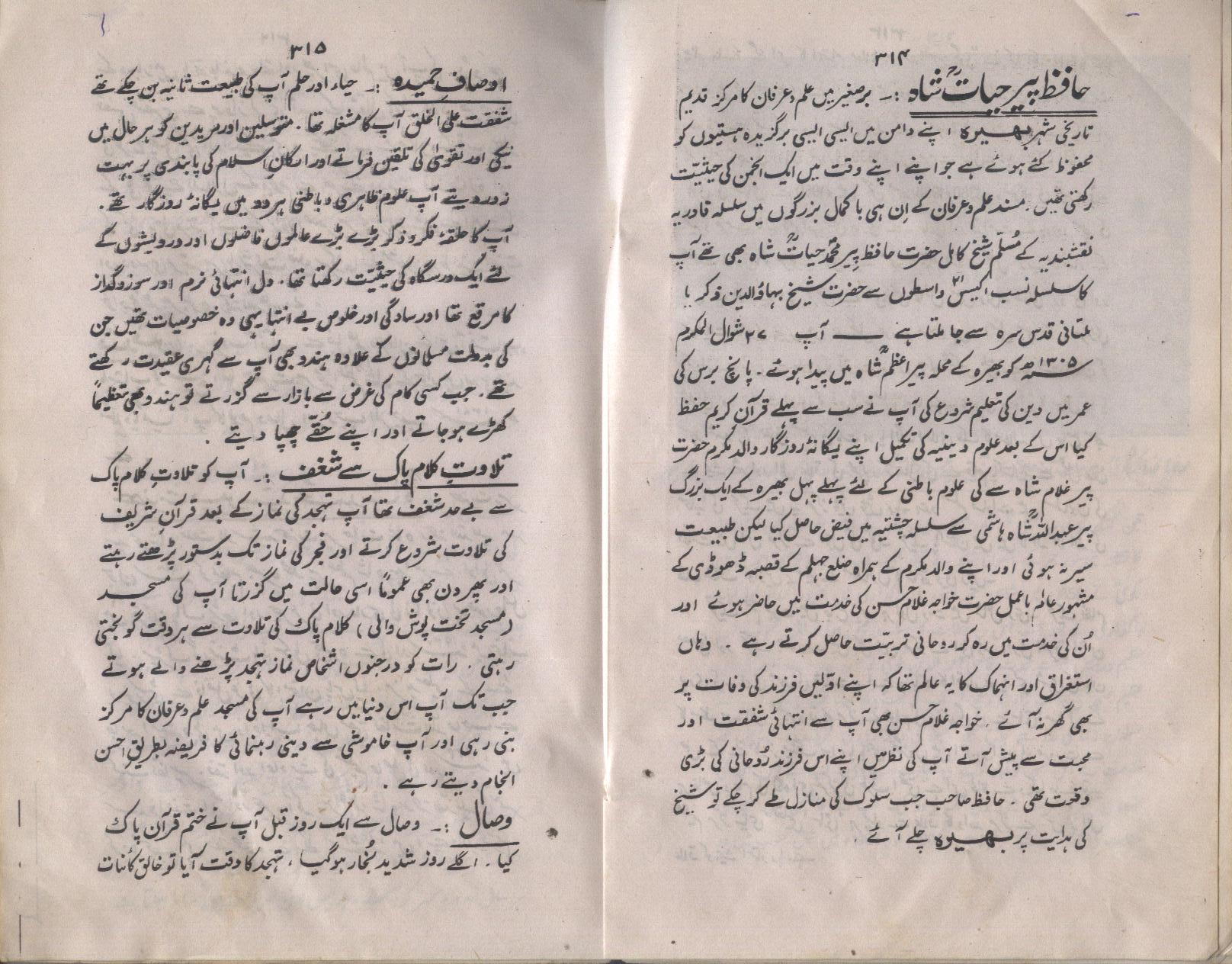
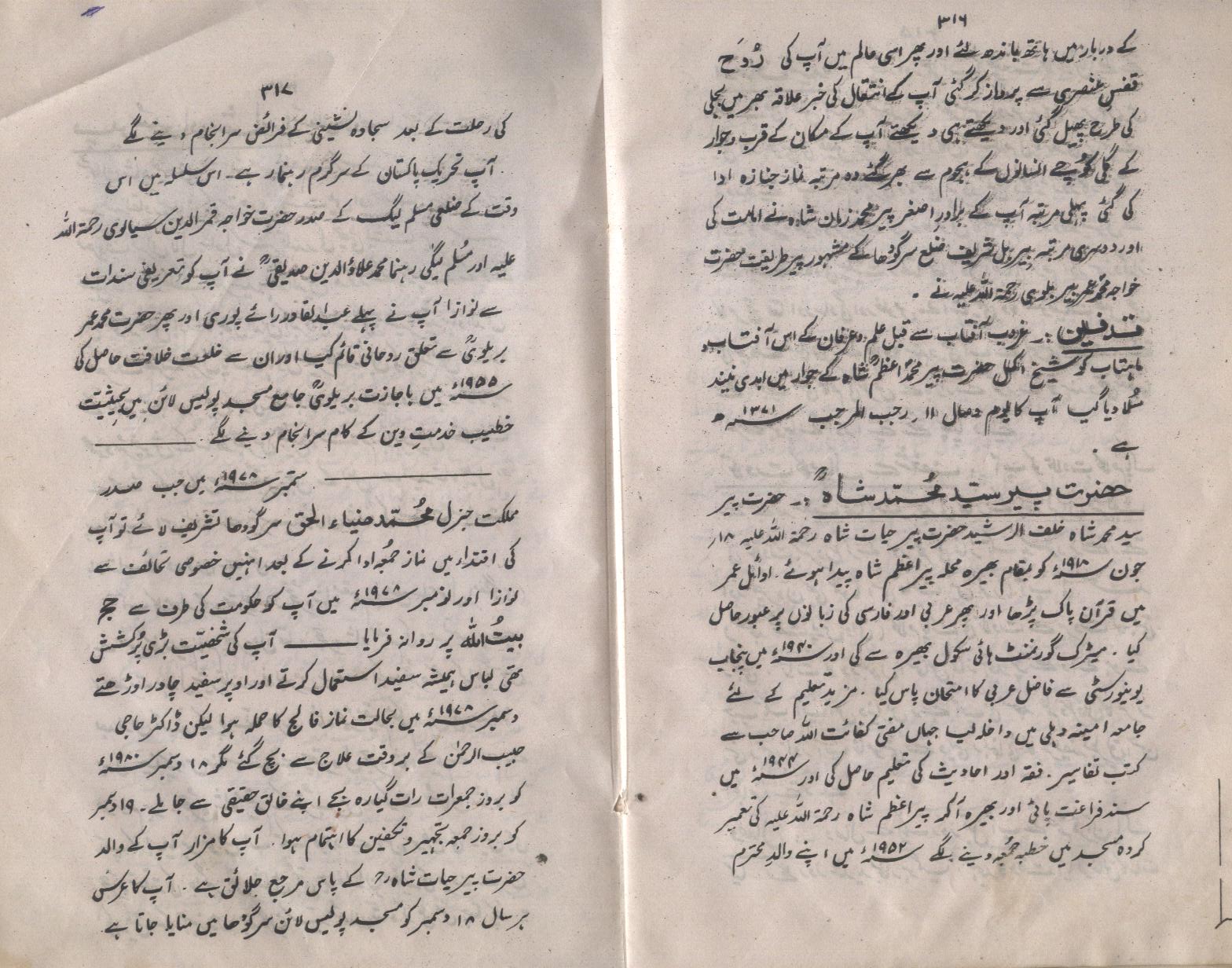
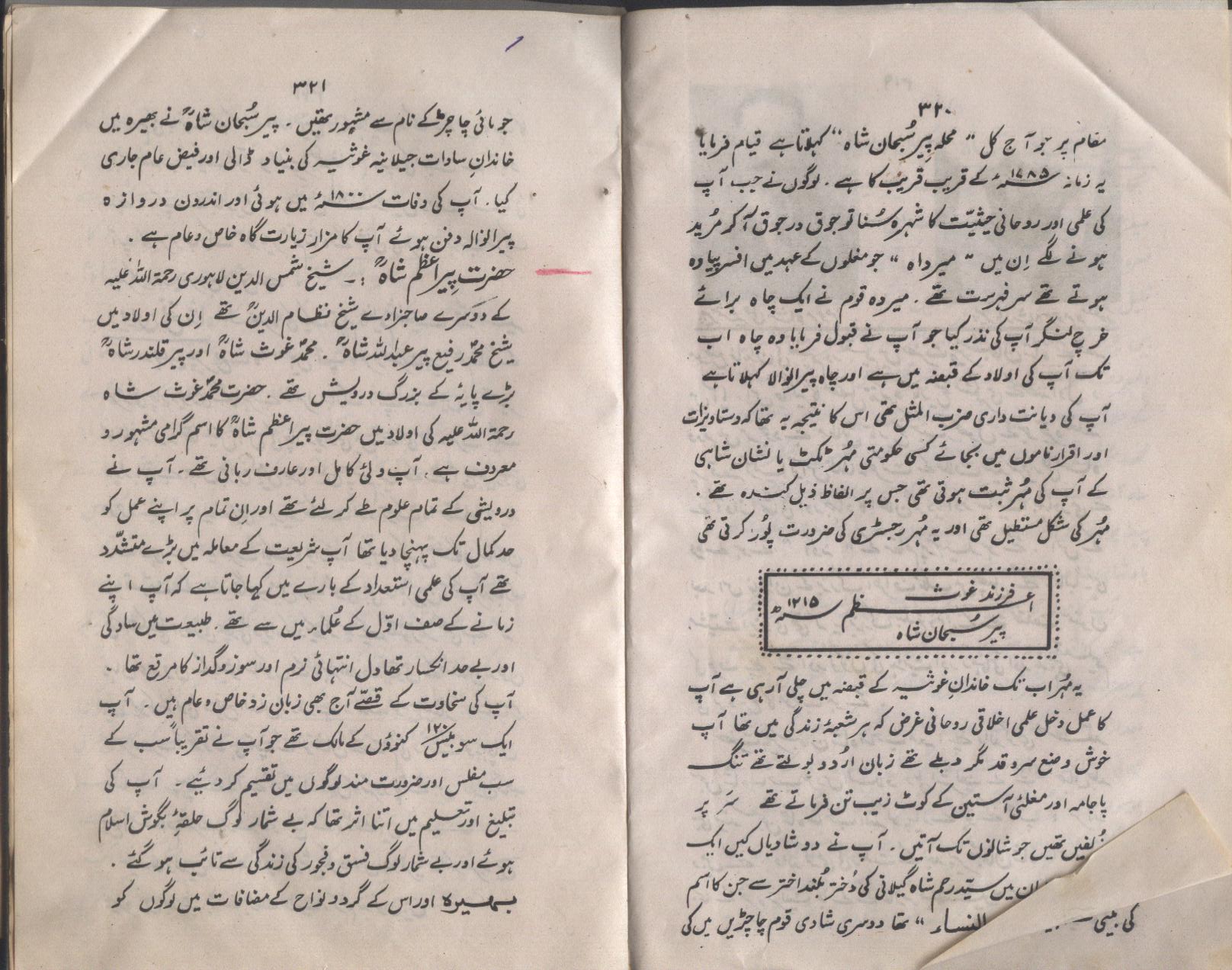
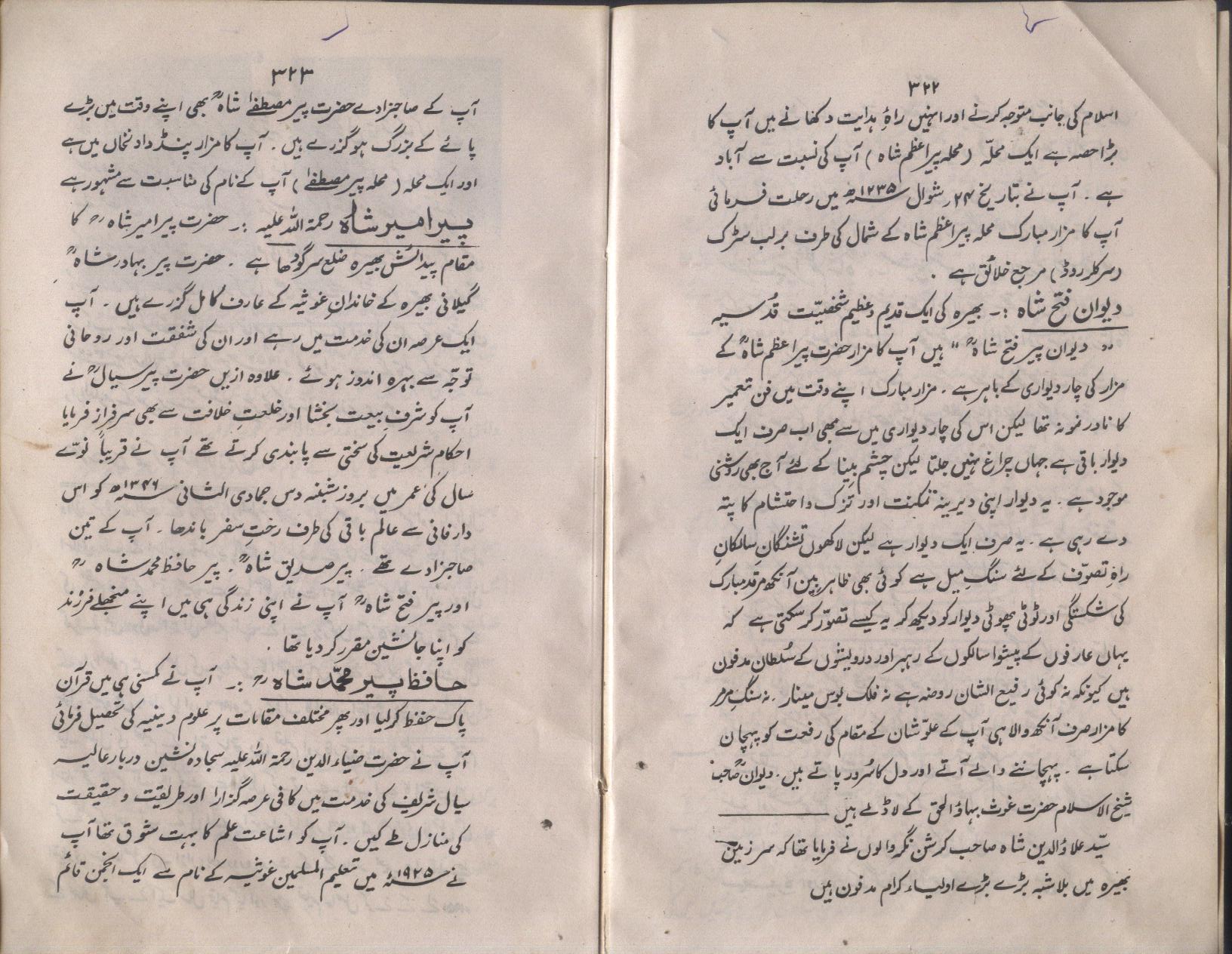
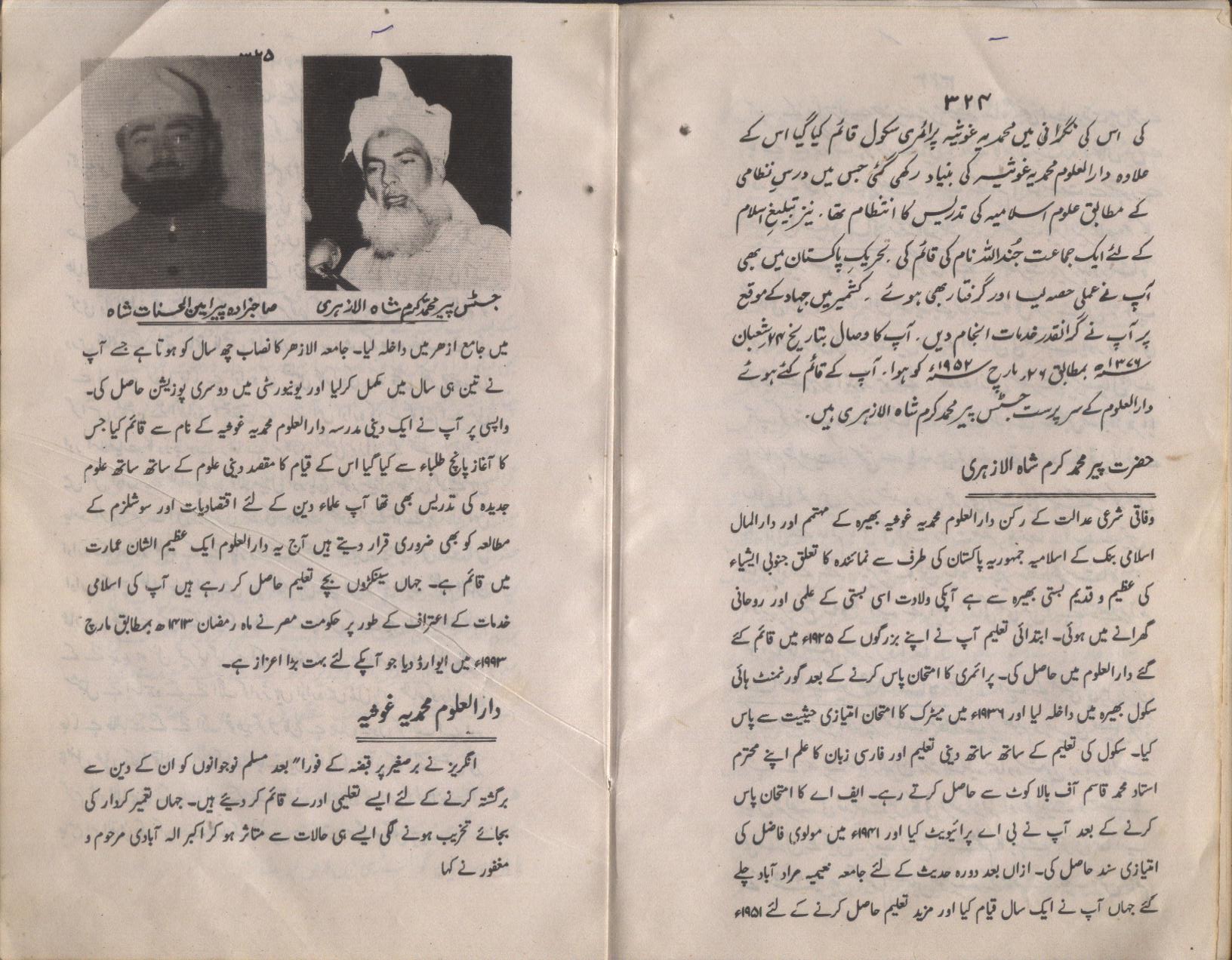

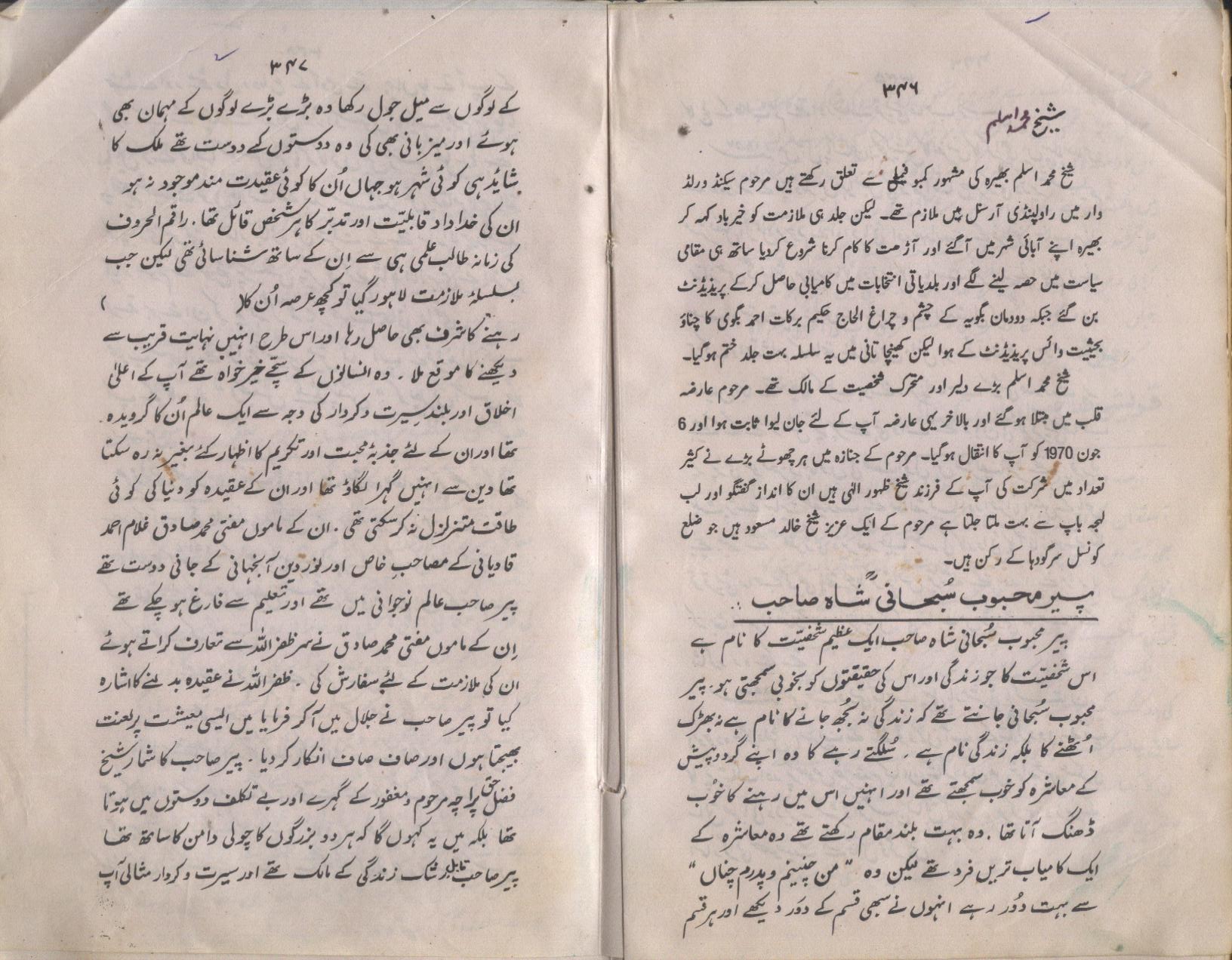


hazrat khawja shaikh abdul shakoor nawshery rh jo hazrat yeha atki rh ke khalifa hain jika mazar sayed peshawr me hain unki halate zidgi likhe meharbani hogi
ReplyDeleteok sir
ReplyDeleteفضولیات اور من گھڑت اور لگتا ہے بغیر پڑھے کاپی کرکے لگادیا گیا ہے۔ سندھ کے حباری بنی ہاشم سے نہیں تھے۔ بندہ تھوڑی تحقیق ہی کرلیتا ہے۔
ReplyDelete